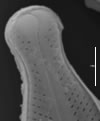Images
Click any image to enlarge...
LM image scalebar = 10 µm = 38 pixels
SEM image scalebar = 5 µm
Observations
| Observations: | Tyler Kohler |
|---|---|
| Length: | 25-53 µm |
| Width: | 6-9.7 µm |
| Striae: | 20-27 in 10 µm |
Description:
Valves lanceolate with protracted, capitate ends. Valve length 25-46 µm, width 6-8.5 µm. Axial area linear and narrow. Central area forming a relatively broad fascia (stauros), stongly widened towards the valve margins. Raphe filiform. Striae are composed of small areolae and number 20-26 in 10 µm. Striae radiate throughout and slightly more broadly spaced near the central valve. Pseudosepta absent. SEM: Externally, striae are dash-like and terminate before the distal valve ends forming a distinct hyaline area. Distal raphe curved. Proximal raphe ends are simple. Internally, areolae extend through the valve and form the same dash-like structure as the external expression. Distal raphe ends terminate in a helictoglossa. Central stauros is raised internally.
| Morphology: | Naviculoid |
|---|---|
| Distribution: | Southern hemisphere |
Autecology:
Notes:
The species from the McMurdo Dry Valleys does not conform entirely to described species. It is most similar to Stauroneis latistauros and S. pseudagrestris Lange-Bertalot et Werum, however, it differs from both taxa in significant ways. S. latistauros, with a striae count of 19-21 in 10 µm, has more coarse striae than the 20-26 striae in 10 µm of the McMurdo Dry Valleys taxon. S. pseudoagrestis, with a striae count of 24-26 in 10 µm overlaps more closely with the striae count of the McMurdo Dry Valley taxon. However, the punctae of S. pseudoagrestris are noted as not visible in the light microscope. The McMurdo Dry Valley taxon also differs from Stauroneis anceps Ehrenberg and S. strelnikovae Van de Vijver. S. anceps possesses rostrate valve ends, as opposed to the protracted, capitate ends of our taxon. S. anceps also has a narrower stauros, in contrast to the distinctive hourglass-shaped stauros of our taxon. S. strelnikovae is larger and broader than our taxon, and also has narrower central fascia lacking the hourglass-shaped stauros. We tentatively align our species with S. latistauros and note that this taxon is described from Maritime Antarctic islands (South Shetland Islands, South Georgia) (Van de Vijver and Lange-Bertalot 2004), where similar species are often larger in size than in the McMurdo Dry Valleys. In previous reports from the Dry Valleys this diatom was reported as Stauroneis anceps (Spaulding et al. 1997). Dimensions of the valves found in the Dry Valleys were smaller than those given by Hustedt (1930) and Kellogg et al. (1980) for S. anceps. The specimens in the Dry Valleys appear more narrow than S. latistauros.
McMurdo Dry Valleys Waterbodies with Stauroneis latistauros
- Adams Stream
- Aiken Creek
- Blue Lake
- Bowles Creek
- Canada Stream
- Clear Lake
- Coast Lake
- Commonwealth Glacier
- Commonwealth Stream
- Crescent Stream
- Delta Stream
- Garwood Stream
- Green Creek
- Harnish Creek
- Harnish Creek Tributary
- Huey Creek
- Hughes Glacier Pond
- Lake Fryxell
- Little Sharpe
- Lost Seal Stream
- Many Glaciers Pond
- McKay Creek
- McMurdo Hut Ridge
- Miers Stream
- Onyx River
- Parera Pond
- Picture Pond
- Pond by Clear Lake
- Pond South of Nussbaum Riegel
- Priscu Stream
- Spaulding Pond
- Taylor Glacier
- Upland Pond
- Von Guerard Stream
- Wales Stream
- Wharton Creek
- Wormherder Creek
Original Type Description
| Author: | Van de Vijver & Lange-Bertalot 2004 |
|---|---|
| Length: | 23-46 µm |
| Width: | 7-8 µm |
| Striae: | 19-21 µm |
Original Description:
Valves lanceolate to linear-lanceolate with shortly subrostrate ends as to the smallest and medium-sized specimens, and more or less long-rostrate as to the largest specimens. Length 23-46 µm, breadth 7-8 µm. Pseudosepta absent. Raphe very frequently filiform, sometimes slightly lateral and almost straight. Central endings with short, clearly spaced central pores barely deflected towards the sides. Axial area narrow, linear but commonly distinctly deltoidely widened near the fascia. Central area forming a relatively broad fascia (stauros), strongly widened towards the valve margins. Striae radiate throughout the entire valve, 19-21 in 10 µm. Puncta in the striae 20-25 in µm, running continuously over the junction valve face and mantle.
New combination
| Author: |
|---|
Citations
Index Nominum Algarum (INA):
- If an INA link is available, it will be shown above
- The INA is a bibliographic reference "card file" for algal taxonomy, containing nearly 200,000 names of algae (in the broad sense).
Publications (by year):
- Patrick and Reimer 1966. p. 361, pl. 30, fig. 1. [citation 93(76)]
- Kellogg et al. 1980. p. 186, pl. 1 fig. 28. [citation 64(35)]
- Van de Vijver et al. 2002. Bibliotheca Diatomologica 46: [citation 127(120)]
- Van de Vijver et al. 2004. Bibliotheca Diatomologica 51 [citation 129(121)]
- Esposito et al. 2008. Botany 86: 1378-1392. [citation 137(135)]














